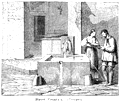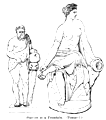Fons
1.
A spring.
2.
A fountain. Ornamental edifices were erected by both the Greeks and Romans over natural
springs, such as the temple of Erechtheus at Athens and of Poseidon at Mantinea (both over
salt springs), that of Salmacis at Halicarnassus (Vitruv. ii. 8.12), and that of the
so-called Grotto of Egeria near Rome. (Cf. Vitruv. viii. 3.7;
Plin. H. N. xxxvi. 154.)
At Rome, also, a good proportion of the water brought into the city by the aqueducts was
devoted to the public fountains. Of these there were two classes, the
lacus (ponds or reservoirs) and the
salientes or
jets d'eau. Agrippa alone is said to have constructed 700
lacus and 500
salientes. Fountains
 |
|
Street Fountain. (Pompeii.)
|
were also used in the
atria of houses (see
Domus), and the basins exhibited a great variety of ornament, sculptural
and otherwise. On the Monte Cavallo at Rome is a fountain representing the colossal figure of
a river-god, perhaps the Rhine, which pours a stream into a basin of granite
 |
|
Statues at a Fountain. (Pompeii.)
|
twenty-seven feet in diameter. There are other excellent examples in the Capitoline
Museum, and the celebrated group of the
Farnese
Bull (q.v.) probably once adorned a fountain. Some of the fountain-statuettes are of
the finest artistic workmanship. See Stieglitz,
Archäol. d. Baukunst,
ii. pt. 2, pp. 76, 79; Middleton,
Remains of Ancient Rome, ii. pp. 329, 349,
350, 351
(London, 1892).






